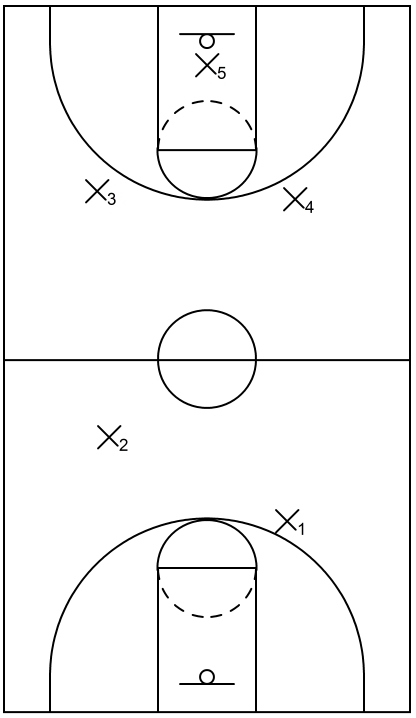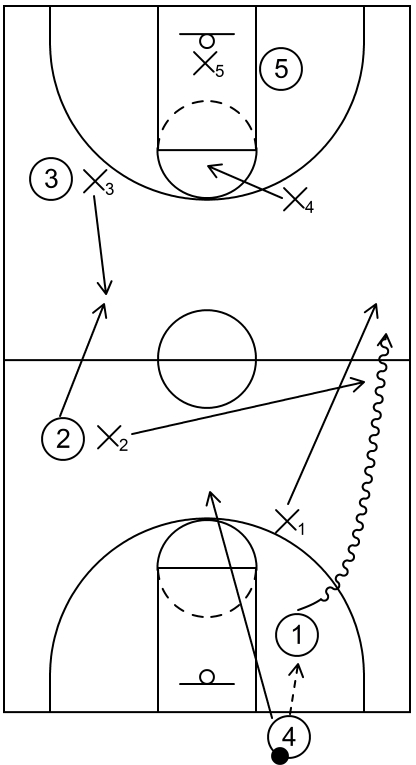What is the run and jump defense in basketball
The run and jump defense is a basketball defensive strategy that utilizes man to man principles, defensive sideline traps, and the defensive switch tactic to disrupt offensive flow which could result in potential turnovers or limited scoring opportunities near the basket or near the perimeter.
Also, the run and jump defense could possibly be useful for teams that have an adequate amount of speed and quickness as well as teams with defenders that can guard multiple positions.
Furthermore, teams that prefer to set traps near the sidelines without implementing an absolute full court press may also consider utilizing the run and jump defense.
What is an example of the initial formation for the run and jump defense

One particular example of the run and jump defense formation is to set up two defenders near the slots in the backcourt, two defenders near the slots in the frontcourt, and the main rim protector, usually the team’s center, near the basket.
Also, the defender that will initially guard the offensive player with the ball should be slightly above the other backcourt defender.
This is important because in the typical run and jump defense, the initial on-ball defender will not implement immediate defensive pressure but instead, the on-ball defender will give the offensive player with the ball the opportunity to dribble towards the middle or towards the sideline.
On the diagram above, X1 is the initial on-ball defender and begins near a slot area outside of the three-point line in the backcourt while X2 is slightly below X1 near the opposite slot.
Furthermore, X3 and X4 begin near slot areas in the frontcourt while X5 stands in the lane area to protect the basket.
What are the primary actions of the run and jump defense
The primary actions of the run and jump defense include the jump switch and the sideline trap.
Jump switch
The jump switch typically involves two or three defenders that will execute a defensive switch to exchange the offensive players that they are currently assigned to.
The jump switch is generally executed when the offensive player with the ball in the backcourt decides to dribble towards the middle of the court.
When that happens, this could initialize a two-man switch or a three-man switch.
Two-man switch
With the two-man switch, the off-ball defender in the backcourt will leave their current assignment to jump switch with the initial on-ball defender to cover the offensive player with the ball.
At the same time, the initial on-ball defender will leave their current assignment so that they can run towards the off-ball offensive player that is initially in the backcourt.
Three-man switch
With the three-man switch, the off-ball defender in the backcourt will leave their current assignment to jump switch with the initial on-ball defender to guard against the offensive player with the ball while the initial on-ball defender will leave their current assignment as before.
However, this time, the off-ball offensive player that was initially in the backcourt was able to sprint into the frontcourt during the jump switching action.
When that occurs, that same off-ball player is essentially too far away for the initial on-ball defender to run towards quickly and effectively.
Therefore, to counter this offensive action, a third defender that is already in the frontcourt will switch to the off-ball player that successfully sprinted into the frontcourt.
At the same time, the initial on-ball defender will run towards the third defender’s previous assignment in the frontcourt.
Moreover, there is an alternative three-man switch where an off-ball defender in the frontcourt jump switches with a backcourt defender while the two backcourt defenders switch assignments as well.
Sideline trap
The sideline trap is typically implemented when the offensive player with the ball in the backcourt decides to dribbles towards a sideline of the court.
When that occurs, the initial on-ball backcourt defender executes a certain amount of defensive pressure until the offensive player with the ball dribbles across the half court line while still near a sideline.
Also, as that happens, the off-ball backcourt defender leaves their assignment to sneak behind the player with the ball to set a trap with the on-ball defender.
As a result, especially if timed properly, the player with the ball will be in what is generally known as a coffin corner.
Essentially, the player with the ball has already crossed the half court line into the frontcourt while being near a sideline.
In other words, the player with the ball would be guarded by “four” defenders; the initial on-ball defender, the sneaking off-ball defender, the sideline, and the half court line.
Furthermore, as that occurs, the two off-ball frontcourt defenders near the slots will attempt to take away easy passing options for the player with the ball that is trapped in the coffin corner.
From that point, that same offensive player with the ball most likely will not have many options to release the pressure and this, in turn, could lead to potential turnovers.
What are examples of defensive rotations within the run and jump defense
Example 1

This is an example of the two-man switch within the run and jump defense. To start, 1 receives the ball from 4 and when that happens, X1 does not implement defensive pressure yet but instead, stays beyond the three-point line.
Next, 1 decides to dribble towards the middle of the court. When that occurs, X2 covers 1 with an automatic jump switch while X1 exchanges to guard 2. Also, X1 is able to switch before 2 moves into the frontcourt.
Example 2

This is an example of a three-man switch within the run and jump defense. To begin, 1 receives the ball from 4 and when that occurs, X1 does not implement defensive pressure until 1 commits to the middle or sideline.
For this case, 1 commits to the middle which causes X2 to jump switch with X1. However, at the same time, 2 successfully sprints into the frontcourt.
This basically means that X1 will probably not have enough time to recover before 2 receives a potential pass from 1.
So, to alleviate this possible issue, 2 gets covered by X3 via a defensive switch while X1 can run towards 3 via another defensive switch.
Example 3

This is an example of an alternative three-man switch within the run and jump defense. To start, 1 receives the ball from 4 and when that occurs, X1 stays back to examine which direction 1 will dribble towards.
For this case, 1 decides to dribble towards the middle. As a result, X2 executes a jump switch with X1. However, 1 counters that jump switch with a dribble move and gets around X2 while X1 has already committed to running towards 2.
Therefore, to mitigate the offensive dribble action by 1, X4 can execute a jump switch with X2 and contain 1 with solid defensive pressure.
Also, at the same time, X2 can guard against 4 after the inbound pass.
Example 4

This is an example of the sideline trap within the run and jump defense. To begin, 1 receives the ball from 4. Next, 1 decides to dribble towards a sideline.
When that occurs, X1 implements defensive pressure to contain 1 near that sideline.
At the same time, X2 leaves their assignment and attempts to sneak behind as 1 dribbles into the frontcourt.
Following that, X1 and X2 can set a sideline trap while 1 is in the coffin corner.
Furthermore, 2 could get covered by X3 upon sprinting into the frontcourt. Moreover, X4 could slide over near the high post area to stand in the gap between 3 and the ball.
Therefore, if 3 was to be the recipient of a skip pass from 1, then X4 could potentially intercept that pass.
Related: The Principles of Run and Jump Defense – Basketball Growth Mindset